AMD FX-8370E CPU Review: Vishera Down to 95W, Price Cuts for FX
by Ian Cutress on September 2, 2014 8:00 AM ESTGaming Benchmarks
F1 2013
First up is F1 2013 by Codemasters. I am a big Formula 1 fan in my spare time, and nothing makes me happier than carving up the field in a Caterham, waving to the Red Bulls as I drive by (because I play on easy and take shortcuts). F1 2013 uses the EGO Engine, and like other Codemasters games ends up being very playable on old hardware quite easily. In order to beef up the benchmark a bit, we devised the following scenario for the benchmark mode: one lap of Spa-Francorchamps in the heavy wet, the benchmark follows Jenson Button in the McLaren who starts on the grid in 22nd place, with the field made up of 11 Williams cars, 5 Marussia and 5 Caterham in that order. This puts emphasis on the CPU to handle the AI in the wet, and allows for a good amount of overtaking during the automated benchmark. We test at 1920x1080 on Ultra graphical settings.
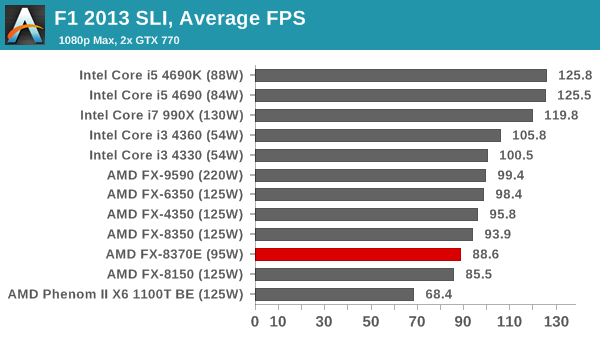
In all combinations, the 8370E and the 8150 duke it out. F1 2013 seems to be an Intel dominated title, given the i3 and outperform the FX-9590.
Bioshock Infinite
Bioshock Infinite was Zero Punctuation’s Game of the Year for 2013, uses the Unreal Engine 3, and is designed to scale with both cores and graphical prowess. We test the benchmark using the Adrenaline benchmark tool and the Xtreme (1920x1080, Maximum) performance setting, noting down the average frame rates and the minimum frame rates.
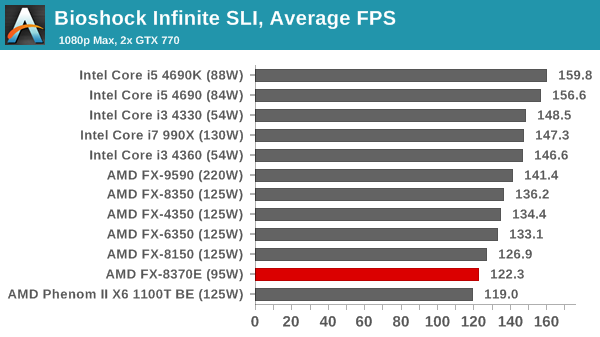
The FX-8350 again fits in just beneath the FX-8150, but for a lower power consumption.
Tomb Raider
The next benchmark in our test is Tomb Raider. Tomb Raider is an AMD optimized game, lauded for its use of TressFX creating dynamic hair to increase the immersion in game. Tomb Raider uses a modified version of the Crystal Engine, and enjoys raw horsepower. We test the benchmark using the Adrenaline benchmark tool and the Xtreme (1920x1080, Maximum) performance setting, noting down the average frame rates and the minimum frame rates.
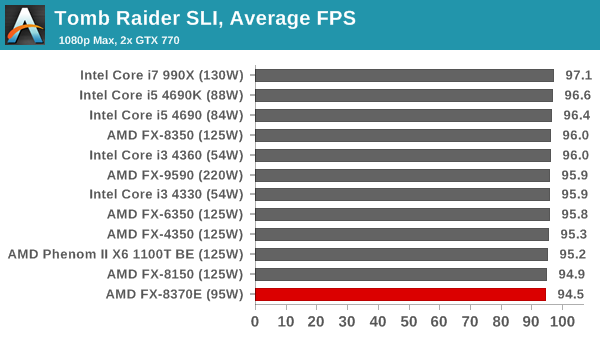
Tomb Raider continues to be CPU agnostic, even around the FX quad thread CPUs.
Sleeping Dogs
Sleeping Dogs is a benchmarking wet dream – a highly complex benchmark that can bring the toughest setup and high resolutions down into single figures. Having an extreme SSAO setting can do that, but at the right settings Sleeping Dogs is highly playable and enjoyable. We run the basic benchmark program laid out in the Adrenaline benchmark tool, and the Xtreme (1920x1080, Maximum) performance setting, noting down the average frame rates and the minimum frame rates.
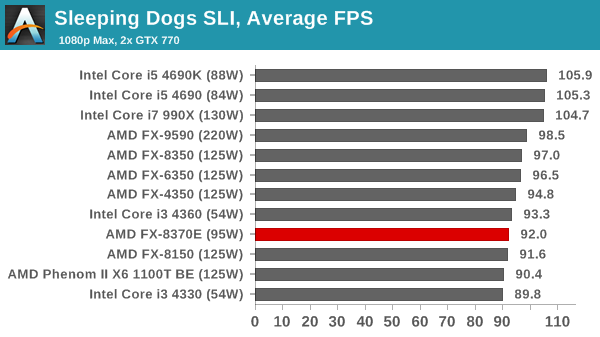
The eight threads offers some advantage in minimum frame rates, but average frame rates are still around the FX-8150.
Battlefield 4
The EA/DICE series that has taken countless hours of my life away is back for another iteration, using the Frostbite 3 engine. AMD is also piling its resources into BF4 with the new Mantle API for developers, designed to cut the time required for the CPU to dispatch commands to the graphical sub-system. For our test we use the in-game benchmarking tools and record the frame time for the first ~70 seconds of the Tashgar single player mission, which is an on-rails generation of and rendering of objects and textures. We test at 1920x1080 at Ultra settings.
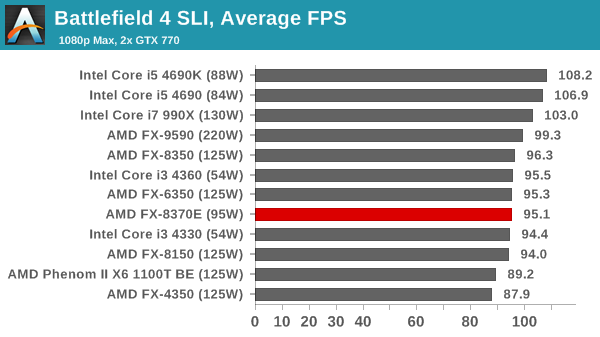
The FX-8370E stretches its legs a little in terms of minimum frame rates, particularly in SLI, however it is handily beaten by the i3-4330.















107 Comments
View All Comments
Germanicus - Tuesday, September 2, 2014 - link
Everyone has different ethics. Not trolling.Most everyone here is parroting the same points. This isn't adding anything to the discussion. It is a bash-fest.
Germanicus - Tuesday, September 2, 2014 - link
Fawn? Whatever. Never implied that. I wish they were more competitive.silverblue - Tuesday, September 2, 2014 - link
These sorts of chips do rather well in multithreaded workloads. Most games really don't fit this category yet.I'd get the 8320E over this any day though - there's a rather uncomfortable price difference despite what should be very similar performance. Still, an eight-core Steamroller clocked at even 8320 (125W edition) speeds would outperform pretty much all of AMD's FX line and use less power, but I imagine not by quite enough to warrant its release.
bsim500 - Tuesday, September 2, 2014 - link
"These sorts of chips do rather well in multithreaded workloads. Most games really don't fit this category yet."That's the problem word - "yet". AMD has spent the last 5 years endlessly waiting for "the day after tomorrow's games" instead of giving people what they want today : +50-70% faster cores (which runs all software faster multi-threaded or not) just to close the gap with Intel...
duploxxx - Wednesday, September 3, 2014 - link
did you also care to look at multithreaded benchmarks where the 54W get trashed everywhere..multithreading is still the future and you just put yourself back to 2009 and earlier, but hey you do run a few fps faster which you can't even notice within the game :).
beginner99 - Tuesday, September 2, 2014 - link
My 5 year old 45 nm Lynnfield is faster single-threaded than this thing. OMG.just4U - Tuesday, September 2, 2014 - link
According to bench.. it's somewhat above Intel's core2 8x and just below their first i5/3s.TiGr1982 - Tuesday, September 2, 2014 - link
Which is not surprising, because Piledriver is slower at the same clocks than Core 2, let alone any Core i7.MrSpadge - Tuesday, September 2, 2014 - link
Alright, AMD made it clear they don't think it's worth to upgrade their CPUs to their current architecture (they already have the cores) and at least 28 nm manufacturing (cheaper per transistor). And they could be right in that people just wouldn't buy enough of these to make up for the development costs.So they try to make the best use of what they have. Yet.. do they? I could imagine them doing something much better with 4-module Piledriver dies: put 2 of them onto the same package, like they do for Opterons! Sell them at decent prices and anyone wanting cheap multithread number crunchers might be interested. They might hurt 1 and 2 socket Opteron sales a bit.. but without any updates, how competitive are they anyway? And you can't put much RAM into desktop boards anyway, so this wouldn't be that much of a thread.
TiGr1982 - Tuesday, September 2, 2014 - link
Two dies won't fit in AM3+; so what you suggest is rebranding the socket G34 for a desktop and selling it cheaper, I suppose. Still a questionable idea IMHO to me.